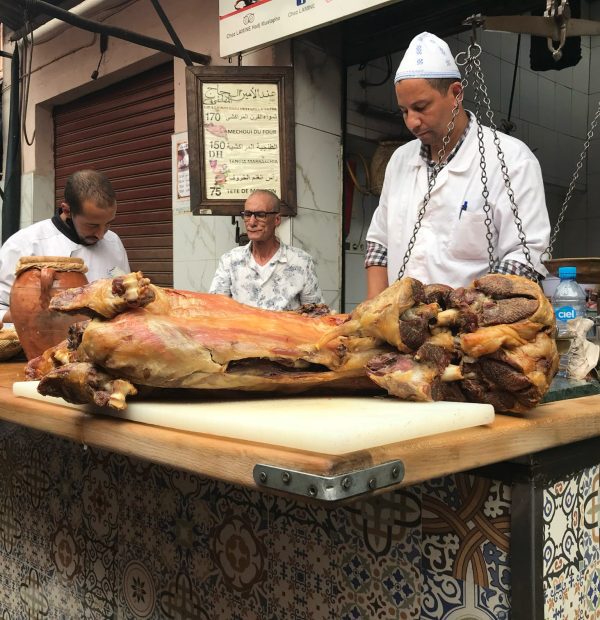
Food in Morocco:An Unforgettable Celebration of its Traditions 2025
Moroccan cuisine is a flavourful and aromatic reflection of the country’s diverse cultural heritage, blending Berber, Arab, Moorish, Jewish, and Mediterranean influences. It is known for its rich and complex flavors, the use of a wide range of spices, and the combination of sweet and savory elements.
Moroccan cuisine’s diverse and enticing flavors have gained popularity worldwide, and many Moroccan restaurants can be found in different countries. When visiting Morocco, exploring the local food markets, trying street food, and experiencing traditional dishes are a must to fully appreciate the country’s culinary delights. Here are some highlights of Moroccan food:
Traditional Moroccan Dishes
Tagine
One of Morocco’s most iconic dishes, tagine refers to both the traditional clay pot and the slow-cooked stew prepared inside it. The tagine can contain various ingredients, such as meat (often lamb or chicken), vegetables, dried fruits, and a blend of spices. The slow cooking method allows the flavors to meld and creates tender, succulent dishes.
Couscous
Often considered Morocco’s national dish, couscous is made from steamed semolina wheat granules and typically served with vegetables and meat (chicken, lamb, or beef). It is a staple in Moroccan households and a central part of Friday family meals.
Pastilla (B’stilla)
A unique and delicious Moroccan pie, pastilla is traditionally made with layers of thin pastry filled with spiced pigeon or chicken, almonds, and eggs. It’s a fusion of sweet and savory flavors, and the pie is dusted with powdered sugar and cinnamon.
Harira
A hearty and nutritious soup often served during Ramadan, harira is made with tomatoes, lentils, chickpeas, meat (usually lamb or beef), and a blend of aromatic spices. It is a comforting and flavorful dish that breaks the fast during the holy month.
Mechoui
Mechoui is a beloved and cherished dish in Moroccan cuisine, representing the warm hospitality and communal spirit of the Moroccan people. A festive and succulent dish, mechoui refers to slow-roasted, spiced lamb or sheep, often prepared for special occasions and celebrations. It involves roasting a whole lamb or sheep over an open fire or in a special underground oven called a “ferran” or “tanour.” A whole section of the Marrakech medina is devoted to Mechoui, an experience not just a meal.
Salads and Accompaniments
Moroccan Salads
Moroccan cuisine is famous for its array of delicious salads, such as zaalouk (eggplant and tomato salad), taktouka (roasted pepper salad), and Moroccan carrot salad. These salads are typically served as appetizers or accompaniments to main dishes.
Beverages and Sweets
Mint Tea (Maghrebi Tea)
A symbol of Moroccan hospitality, mint tea is a sweet and fragrant beverage made with green tea leaves, fresh mint, and sugar. It is traditionally poured from a height to create froth and served in small glasses.
Moroccan Sweets
Moroccan desserts are a delightful array of pastries and sweets. Popular treats include almond-based pastries like almond briouats, sesame-coated chebakia, and date-filled ma’amoul.
Seafood Specialties
Seafood Dishes
With a long coastline, Morocco offers a wide variety of fresh seafood dishes, such as grilled sardines, fish tagine, and seafood pastilla.
Unique and Traditional Dishes
Rfissa
Rfissa is a traditional Moroccan dish that holds significant cultural and social importance, often served during special occasions and celebrations. The main components of Rfissa are shredded msemen (Moroccan flatbreads) and a flavorful chicken stew. The chicken is cooked with a blend of aromatic spices such as ginger, saffron, turmeric, fenugreek, and ground black pepper. The stew is often enriched with lentils, onions, and sometimes vegetables like carrots and chickpeas.
Babbouche (Moroccan Snails)
Moroccan snails are a rich, warm dish that’s especially popular during the winter. Vendors cook the snails in pots with hot water, salt, special spices, and herbs. Recipes vary but can feature more than 15 seasonings, including the likes of licorice root, lavender, tea leaves, and thyme. After cooking, the snails are served in small bowls with their broth. A toothpick is the tool of choice for extracting the creature from its white-and-brown shell. The snails and their broth are considered to have various health benefits, including alleviating rheumatism and colds.
Tanjia
This meat dish slow-cooks in the embers that heat Moroccan bathhouses.
Amlou
Amlou is a thick brown paste with a texture similar to peanut butter obtained by grinding roasted almonds and then mixing them with honey and argan oil. Amlou is known as a specialty from the South of Morocco and is usually used as a healthy dip or spread since its key ingredient is argan oil. It is usually served for breakfast or afternoon tea with pancakes and pastries.
Exploring Moroccan food is a journey of flavors, traditions, and cultural heritage that reflects the country’s vibrant history and warm hospitality.
Table of Contents
contents






